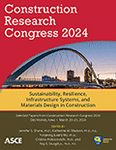Quantifying the Thermal Comfort Improvement in a Redevelopment Project in Comparison to Semi-Permanent Homes in a Densely Populated Slum
Publication: Construction Research Congress 2024
ABSTRACT
Housing marginalized communities in resilient homes is an important aspect of building a climate-resilient population. In this study, the daily temperatures in a semi-permanent home in a densely populated slum have been compared to those in the homes in a consciously designed in situ slum rehabilitation project built using vernacular technologies. On monitoring the indoor and outdoor temperatures over nine months under both conditions, results clearly indicated that the permanent homes are significantly cooler than the semi-permanent homes or slums by an average of 10%−15% due to the higher thermal mass, insulation, and ventilation. The temperatures are also more stable, with lesser variation between seasons. The paper demonstrates that through minimal additional investments and good design prioritizing thermal comfort and ventilation, low-cost slum rehabilitation projects could lead to a healthier and more productive society. Such field investigation studies support robust modeling and design of rehabilitation homes.
Get full access to this article
View all available purchase options and get full access to this chapter.
REFERENCES
Beeghley, L., and D. Donnelly. 1989. “The consequences of family crowding: A theoretical synthesis.” Lifestyles, 10: 83–102. Springer.
Calhoun, J. B. 1962. “Population density and social pathology.” Sci. Am., 206 (2): 139–149. JSTOR.
Debnath, R., R. Bardhan, and R. K. Jain. 2017. “A data-driven and simulation approach for understanding thermal performance of slum redevelopment in Mumbai, India.” Proc. of the 15th IBPSA Conf, San Francisco, USA.
Djamila, H., C.-M. Chu, and S. Kumaresan. 2014. “Effect of humidity on thermal comfort in the humid tropics.” J. Build. Constr. Plan. Res., 2 (02): 109. Scientific Research Publishing.
Eromobor, S. O., and D. K. Das. 2013. “Dynamic Modelling Approach for Designing Sustainable Green Buildings.” SB13 South. African Conf., (October): 2–11.
Francis, A., and A. Thomas. 2020. “Decoupling Housing Growth from Environmental Impact: A Pathway to Sustainability through a System Dynamics Simulation Approach.” Proc. of the Constr. Res. Congr. 2020 Infrastruct. Syst. Sustain., 268–277. ASCE, Reston, VA.
Joshi, S. S., T. J. Lesser, J. W. Olsen, and B. F. O’Hara. 2016. “The importance of temperature and thermoregulation for optimal human sleep.” Energy Build., 131: 153–157. Elsevier.
Mahadevia, D., M. Pathak, N. Bhatia, and S. Patel. 2020. “Climate change, heat waves and thermal comfort—reflections on housing policy in India.” Environ. Urban. ASIA, 11 (1): 29–50. SAGE Publications Sage India: New Delhi, India.
Mukhopadhyay, B., C. A. Weitz, and K. Das. 2021. “Indoor heat conditions measured in urban slum and rural village housing in West Bengal, India.” Build. Environ., 191: 107567. https://doi.org/https://doi.org/10.1016/j.buildenv.2020.107567.
Nutkiewicz, A., R. K. Jain, and R. Bardhan. 2018. “Energy modeling of urban informal settlement redevelopment: Exploring design parameters for optimal thermal comfort in Dharavi, Mumbai, India.” Appl. Energy, 231: 433–445. Elsevier.
Programme, U. N. H. S. 2006. Meeting Development Goals in Small Urban Centres: Water and Sanitation in the World’s Cities, 2006. UN-HABITAT.
Ramin, B. 2009. “Slums, climate change and human health in sub-Saharan Africa.” Bull. World Health Organ. SciELO Public Health. 87: 886–886A.
Samuel, D. G. L., K. Dharmasastha, S. M. S. Nagendra, and M. P. Maiya. 2017. “Thermal comfort in traditional buildings composed of local and modern construction materials.” Int. J. Sustain. Built Environ., 6 (2): 463–475. The Gulf Organisation for Research and Development. https://doi.org/10.1016/j.ijsbe.2017.08.001.
Seppanen, O. A., and W. J. Fisk. 2004. “Summary of human responses to ventilation.” Indoor air, 14 (s 7): 102–118.
Sundell, J. 2004. “On the history of indoor air quality and health.” Indoor Air, 14 (s 7): 51–58.
Valins, S., and A. Baum. 1973. “Residential group size, social interaction, and crowding.” Environ. Behav., 5 (4): 421–439. Sage Publications Sage CA: Thousand Oaks, CA.
Wang, J., M. Kuffer, R. Sliuzas, and D. Kohli. 2019. “The exposure of slums to high temperature: Morphology-based local scale thermal patterns.” Sci. Total Environ., 650: 1805–1817. https://doi.org/https://doi.org/10.1016/j.scitotenv.2018.09.324.
Information & Authors
Information
Published In
History
Published online: Mar 18, 2024
Authors
Metrics & Citations
Metrics
Citations
Download citation
If you have the appropriate software installed, you can download article citation data to the citation manager of your choice. Simply select your manager software from the list below and click Download.
